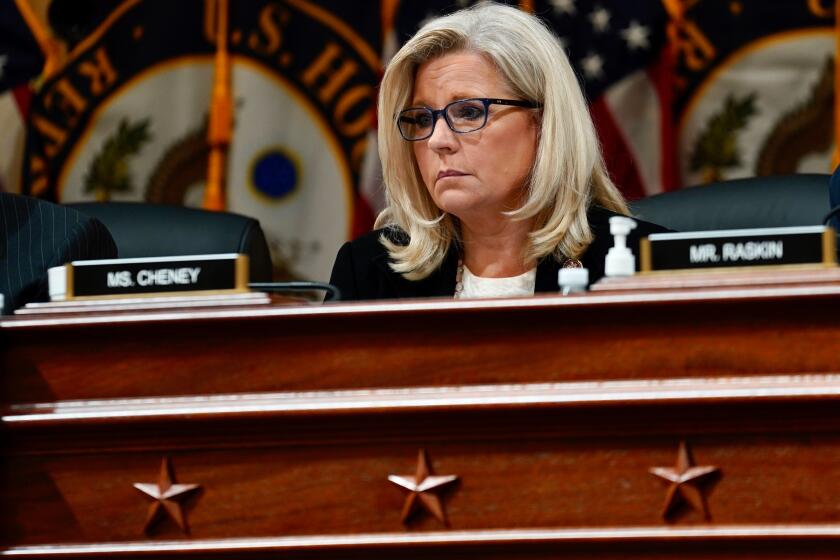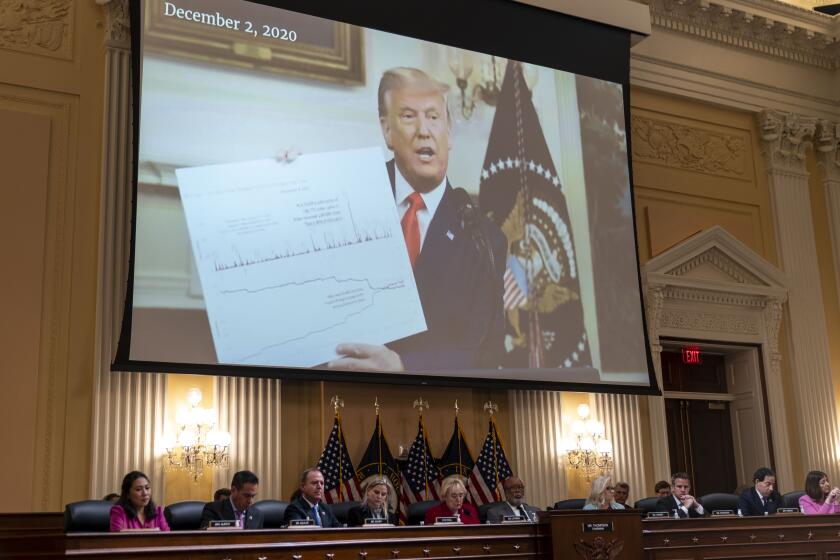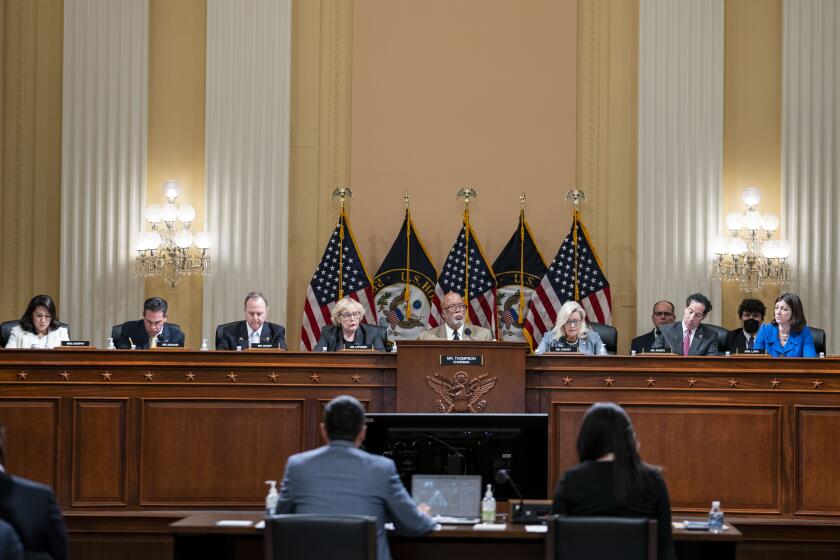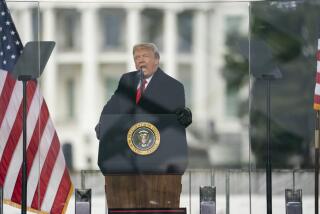Column: The Jan. 6 hearings identify the bad guy in the drama of democracy’s narrow escape — Trump
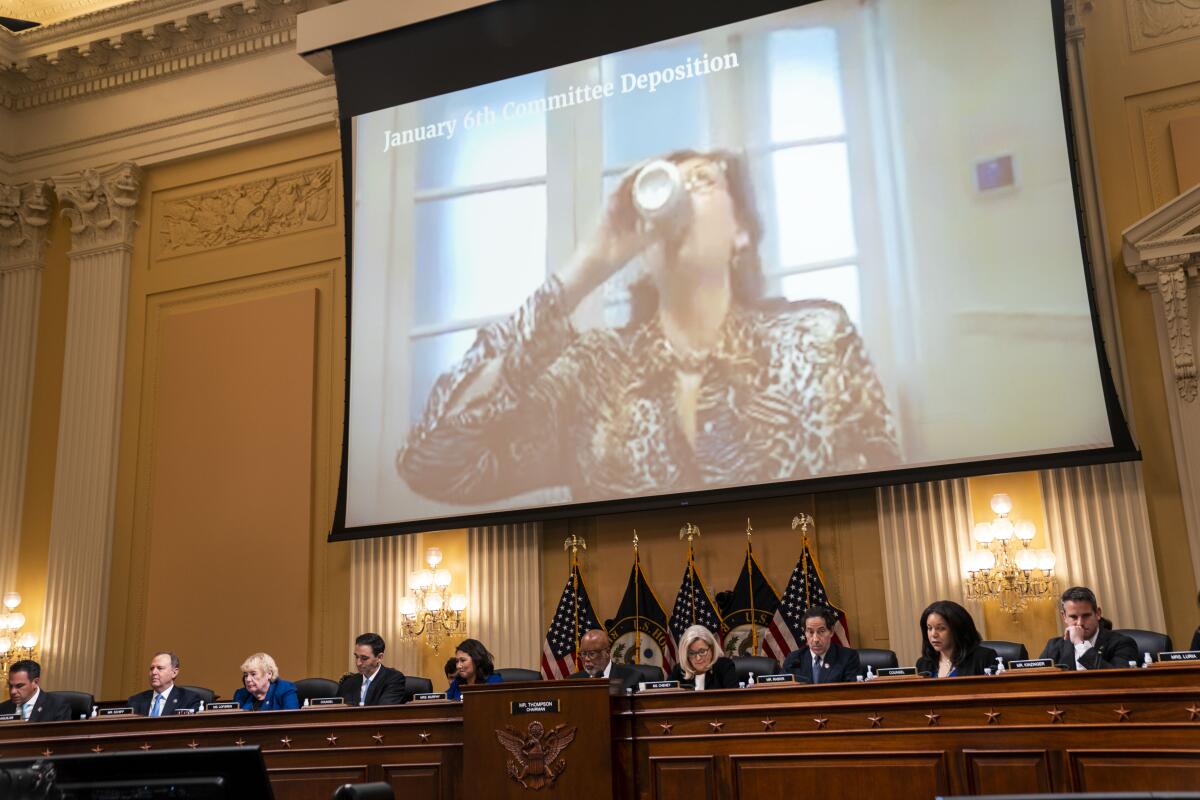
- Share via
Measured by the number of times he was quoted, Donald Trump played a fairly small supporting role in the action described in the Jan. 6 committee hearing on Tuesday.
But as the moving force behind the ugly developments that the committee documented, he was plainly playing the lead.
The dramatic centerpiece of the hearing was a meeting in the White House on Dec. 18, 2020. Except “meeting” barely does it justice: This was a marathon six-hour scrum, roaming around the White House from the Oval Office to the official residence, between Team Crazy — Michael Flynn, lawyer Sidney “Release the Kraken” Powell and others still humoring the president and feeding him the tall tale that he had won the election — and Team Normal, government officials, mainly lawyers, still on board at the Trump White House.
Indeed, one of the most unusual features of the meeting is that it happened in the first place. Outsiders don’t just wander into the Oval Office and, unscheduled, get a sit-down with the leader of the free world.
A ‘previously on...’ segment. A carefully choreographed timeline. A jaw-dropping cliffhanger. All the committee needs now is to stick the landing.
It’s in fact the job description of the White House chief of staff — Mark Meadows, in this case — to keep such informal encounters from happening. But as we’ve heard from the committee, Meadows was something between a cipher and a co-conspirator by December of that year.
When White House counsel Pat Cipollone learned about the interlopers meeting with Trump, he and others rushed to the Oval Office to keep the president from doing damage to himself and the nation. (Said Powell in her taped testimony: “I bet Pat Cipollone set a land speed record.”)
Multiple witnesses testified to what happened next. Shouting, screaming, profanity and even an overture to fisticuffs. As for Trump, just one statement was attributed to him, but it was telling.
We are in a critical constitutional moment, and society as a whole, not just one institution, must renounce Trump’s democracy-destroying lies and actions.
On videotape, Derek Lyons, former White House staff secretary who was present at the meeting, was asked if he remembered the president saying something along these lines: “They [meaning Cipollone] weren’t offering him any solutions, but Sidney Powell and others were, so why not try what Ms. Powell and others were proposing?”
“I do,” Lyons testified.
In other words, the criterion at issue for the president was overturning the will of the people and remaining in power. Details such as the law, evidence and truth were beside the point.
In Tuesday’s narrative, Trump had one more line, the tweet he sent out in the wee hours, after the meeting finally wound down, when he rallied his supporters to come to Washington on Jan. 6, 2021, promising it “will be wild.”
For a prosecutor to connect the president tightly to the events of Jan. 6, important holes would have to be filled in about the conversation during the “unhinged” meeting.
But Trump’s basic strategy seems clear enough: He fastened on the rally as perhaps the best remaining way to hold on to the White House. He had lost court case after court case by then, and he had heard his official circle tell him that he was at the end of the road.
So he called out the cavalry.
If Trump isn’t referred to the Justice Department for prosecution, we risk another Mueller report fiasco.
And the Proud Boys and the Oath Keepers and thousands of others responded. They arrived at the rally at the Ellipse on Jan. 6, where Trump played out one more scene that is highly probative for prosecutors.
Over the objections of official advisors, he maneuvered to insert a reference to Vice President Mike Pence into the official text of his Jan. 6 speech, and in the moment, extemporized more references to Pence and his role in certifying the election, including red meat lines such as, “You’ll never take back our country with weakness. You have to show strength.”
There are no shortage of unethical lawyers and syncophants who will tell a ruthless leader like Trump whatever he wants to hear, including the rogues gallery that had his ear on Dec. 18.
And there are plenty of domestic terrorists like the paramilitary Oath Keepers and the Proud Boys waiting to be called to action. (I prosecuted some of them when I was the U.S. attorney in western Pennsylvania.) Typically they are a ragtag bunch posturing to one another under the whip hand of a charismatic leader, like Stewart Rhodes — as Tuesday’s hearing revealed.
What made the committee’s presentation harrowing is how clearly it showed that these characters were exercising the power of the presidency at the end of Trump’s time in office. They were selling Trump a path to retention of power, and Trump was investing them with the authority to carry out their plans, which became his plans. At the same time, he was divesting advisors such as Cipollone and U.S. Atty. Gen. William Barr of power.
Team Crazy and the likes of Stewart Rhodes deserve our contempt. They plotted to bring the democracy down. But in the drama of our narrow escape, they are the supporting actors.
Their bizarre and malevolent turn on the national stage, and their rise from the obscurity they deserve, took place at the whim of the drama’s protagonist, President Trump.
More to Read
A cure for the common opinion
Get thought-provoking perspectives with our weekly newsletter.
You may occasionally receive promotional content from the Los Angeles Times.
